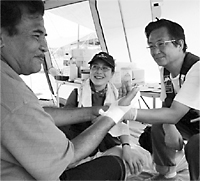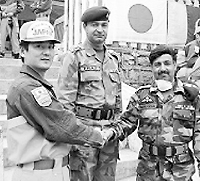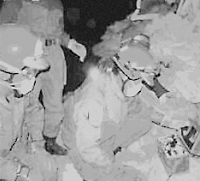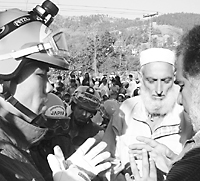Japan's Official Development Assistance White Paper 2007
Box 3. 20 Years of Japan Disaster Relief Teams

The year 2007 marks the 20th anniversary of the entry-into-force of the Law concerning Dispatch of Japan Disaster Relief Teams ("JDR Law") in September 1987. In response to large-scale overseas disasters, Japan Disaster Relief Teams conduct search and rescue operations, provide treatment, and carry out rehabilitation activities as well as emergency activities to mitigate damage. A total of 93 JDR teams (as of November 2007) have been dispatched since the JDR Law came in force.
When a large-scale disaster strikes, it often causes widespread human, material economic or environmental losses, which exceed the ability of the affected country to cope using its own resources. In response to such a disaster, the JDR is expected to promptly help as many disaster victims as possible. Given that the chance of a victim surviving decreases significantly after 72 hours following a disaster, a system is in place to dispatch JDR rescue teams within 24 hours and JDR medical teams within 48 hours after Japan receives a request of assistance from the government of an affected country. Japan, a country prone to natural disasters such as earthquakes and typhoons, has accumulated a wealth of knowledge and technology on disaster relief.
The JDR teams have helped assuage the pains of numerous disaster victims and to bring them a light of hope. For instance, the rescue team dispatched in response to the large earthquake in Algeria in May 2003 worked round the clock with dogged determination to rescue as many lives as possible. After 50 hours following the earthquake, while some overseas teams had stopped their activities, one JDR team member heard a faint voice coming out of the rubble of a collapsed hotel. Believing in the possibility of a survivor, the team searched under the rubble thoroughly and discovered a trapped man beneath the rubble. Working together with a Turkish team working nearby, the team subsequently succeeded in extricating the trapped, but still living, victim.
The JDR medical team dispatched to El Salvador following the earthquake in January 2001 handled the situation with a similar attitude. Not only did the team do their best to save as many lives as possible with limited resources, but they also listened intently to the stories of the patients they attended to. The patients included children who were less fortunate. One day, a child gave a team member a piece of candy. Candies are of extreme value to those children, and this was a special token of gratitude to the JDR medical team. One year later, a monitoring team visited the sites for follow-up and interviewed the director of the local hospital. As the head of the local hospital gave high praise to the meticulous treatment provided by the medical team, not least for earning the trust of patients, a year later a researcher that visited the site for follow-up research mentioned that he was asked numerous times about whether or not there were any more Japanese doctors, and even by patients that the team had already been discharged.
When the Great Hanshin-Awaji Earthquake struck Japan in January 1995, offers of assistance were made by 77 countries regions as well as international organizations, including less affluent ones.
An introduction to persons involved with past international disaster relief activities
-
Dr. Yasufumi Asai, Chairman and Professor, Department of Traumatology and Critical Care Medicine, Sapporo Medical University School of Medicine (Dispatched in December 2004 in response to the Great Sumatra Earthquake and Indian Ocean Tsunami)

(Photo: JICA)

-
Kunihiko Sato: Mobile Rescue Unit, Disaster Prevention Office, Security Division, Metropolitan Police Department; Assistant Police Inspector, Metropolitan Police Department (Dispatched in October 2005 in response to the great earthquake disaster in Pakistan)

-
Satoshi Abe: Fire Lieutenant, Ushigome Fire Station, Tokyo Fire Department (Fire Rescue Task Forces, Eighth Fire District Headquarters at time of dispatch) (Dispatched in December 2004 in response to the Great Sumatra Earthquake and Indian Ocean tsunami and again in October 2005 in response to the great earthquake disaster in Pakistan)

(Photo: Tokyo Fire Department)
-
Go Ichimiya: (Leader) Fifth Special Rescue Team, Haneda Special Rescue Station, Japan Coast Guard (Dispatched in response to the great earthquake disaster in Pakistan in October 2005)



 Next Page
Next Page